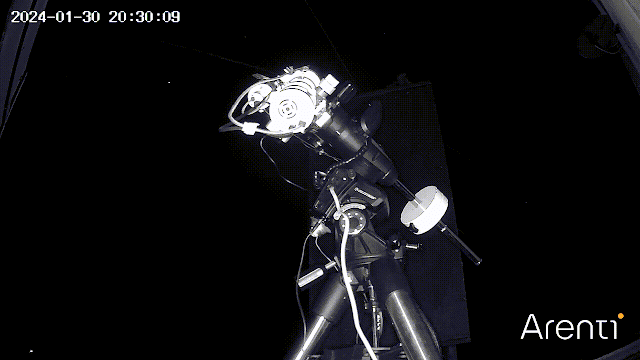M78 and M33 were imaged with Version 2.5.1 of AstroDMx Capture, through an Altair Starwave 60 ED refractor with an 0.8 reducer/flattener and 2" magnetic filter holder with a SkyTech LPRO MAX 2" broadband filter, using an SV605CC cooled, 14 bit OSC CMOS camera. The scope was fitted with a Pegasus FocusCube v2 controlled by AstroDMx Capture via INDI. The scope was mounted on an AVX GOTO mount which was controlled by AstroDMx Capture via an INDI server running on the imaging computer indoors.
The equipment was monitored by a Pan/tilt security IP camera to supervise slews, meridian flips etc.
The IP camera was monitored with a tablet by the imaging computer.
The scope/mount was sent by AstroDMx Capture to the Star Deneb to check focus
The scope pointing at Deneb as seen by the IP camera
An SVBONY SV165 guide scope with a natively connected QHY-5II-M guide camera was used for PHD2 multistar pulse auto-guiding via the INDI server. The auto-guiding was controlled by a separate Linux laptop indoors.
The scope/mount slewing from Deneb to M33 as supervised by the IP camera
AstroDMx Capture captured 55 minutes worth of 5 minute exposures on M33
AstroDMx Capture then, using plate-solving, sent the scope/mount to M78 in Orion and centred the object in the field of view.
The scope slewing from M33 to M78 as supervised by the IP cxamera
AstroDMx Capture captured 100 minutes worth of 5 minute exposures on M78. A meridian flip was required part way through the imaging run on M78, with plate-solving to centre the object in the field of view.
The meridian flip as supervised by the IP camera
The scope pointing at M78 after the meridian flip
AstroDMx Capture capturing data on M78















